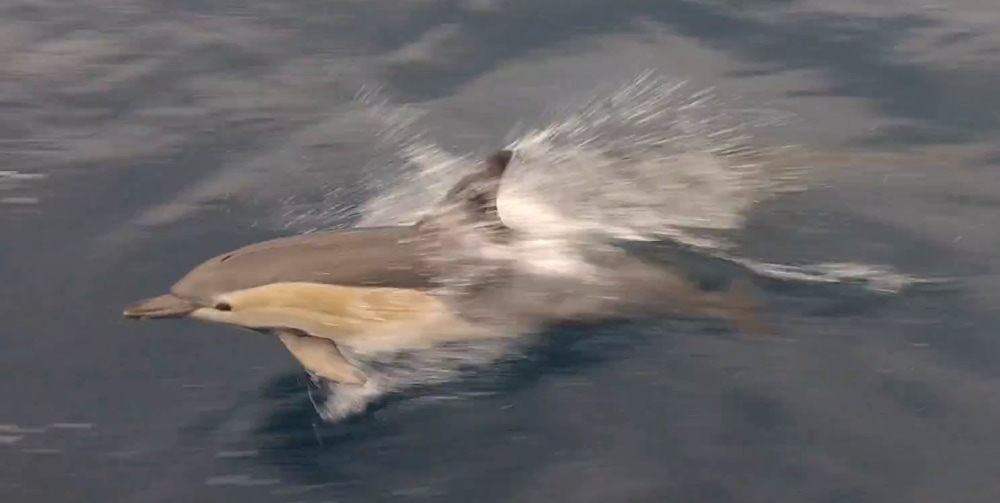A handy summary guide to the dolphins of the Great Ocean Road & East Gippsland, in Victoria Australia.
Dolphins can be seen along the Victorian coast all year round. They frequently play and hunt in the surf near the shore, in pods of 6 or more.

In Victoria we have five very active and acrobatic species of dolphin that can be seen from boats or from land.
Dolphin species possible in East Gippsland and along the Great Ocean Road, Victorian coast, Australia:
Marine Mammals of Victoria: a guide to identification
Indo-Pacific (Indian Ocean) Bottlenose Dolphin
Tursiops aduncus
Size: medium (2.7m)
Beak: longer “bottlenose” than Common Bottlenose Dolphin
Colour: grey back, pale belly, sometimes with spots. Tend to be a lighter grey overall than Common Bottlenose, and lack a blaze of pale under the dorsal fin.
Inshore: yes
This is the most commonly-seen type of dolphin seen from land in East Gippsland and the Great Ocean Road.

..
Common Bottlenose Dolphin
Tursiops truncatus
Size: medium (3m)
Beak: short “bottlenose”
Colour: grey back, pale belly. Dark grey cape has a short blaze of light colour under the dorsal fin.
Inshore: not as much as Indo-Pacific
This species of dolphin is present along the Great Ocean Road and East Gippsland, but often offshore.
..
Burrunan Dolphin
Tursiops australis
Size: small to medium (2.4m)
Beak: short rostrum (bottlenose) like Common Bottlenose Dolphin.
Colour: lighter grey like Indo-Pacific, with three distinct bands of colour: darker on top, mid-grey along sides, white on belly.
Inshore: yes
We see Burrunan Dolphins on the Wildlife Journey in and around Lakes Entrance and Raymond Island, especially in September and May.
Read more about them: Marine Mammal Foundation

..
Short-beaked Common Dolphin
Delphinus delphis
Size: small (2m)
Beak: long slim beak
Colour: grey, tan and black – a very distinctive striped pattern
Inshore: not usually – mostly found offshore; but one small resident population in south-east Port Phillip Bay, Melbourne (1).
Usually seen from boats, offshore in large pods – the Short-beaked Common Dolphin is a playful and strikingly-marked dolphin. Wildlife Coast Cruises sometimes see them on whale watching cruises.

Love cetaceans (whales & dolphins)? Read about the whales we see along the Great Ocean Road.
..
Risso’s Dolphin
Grampus griseus
Size: large (4m)
Beak: none
Colour: grey and white, with marks & striations – older animals whiter
Inshore: no
Seeing these big dolphins is a rare treat. They are striking – older animals are very white on the head and back. Young dolphins are nearly black, but on close view striations can be seen all over their backs – the result of scars from a life in the wild.

Watch this beautiful footage of Risso’s Dolphins from Whale & Dolphin Conservation:
They also have some great pics and information here: WDC Risso’s Dolphin
..
We mostly see dolphins from land, or from the ferry to Raymond Island on the Wildlife Journey. If you are really keen to see dolphins, check out Wildlife Coast Cruises. They have boat cruises all year round that see dolphins. Ask us how you can link their cruise with one of our tours.

..
NOTES & REFERENCES:
Whale & Dolphin Conservation Whale and Dolphin Species Guide: https://au.whales.org/whales-dolphins/species-guide/
Burrunan Dolphin: https://marinemammal.org.au/burrunan-dolphin/
(1) Mason, S et al (2016) Atypical residency of Short-beaked Common Dolphins to a shallow, urbanised embayment in south-eastern Australia in The Royal Society Open Science: https://royalsocietypublishing.org/doi/full/10.1098/rsos.160478

